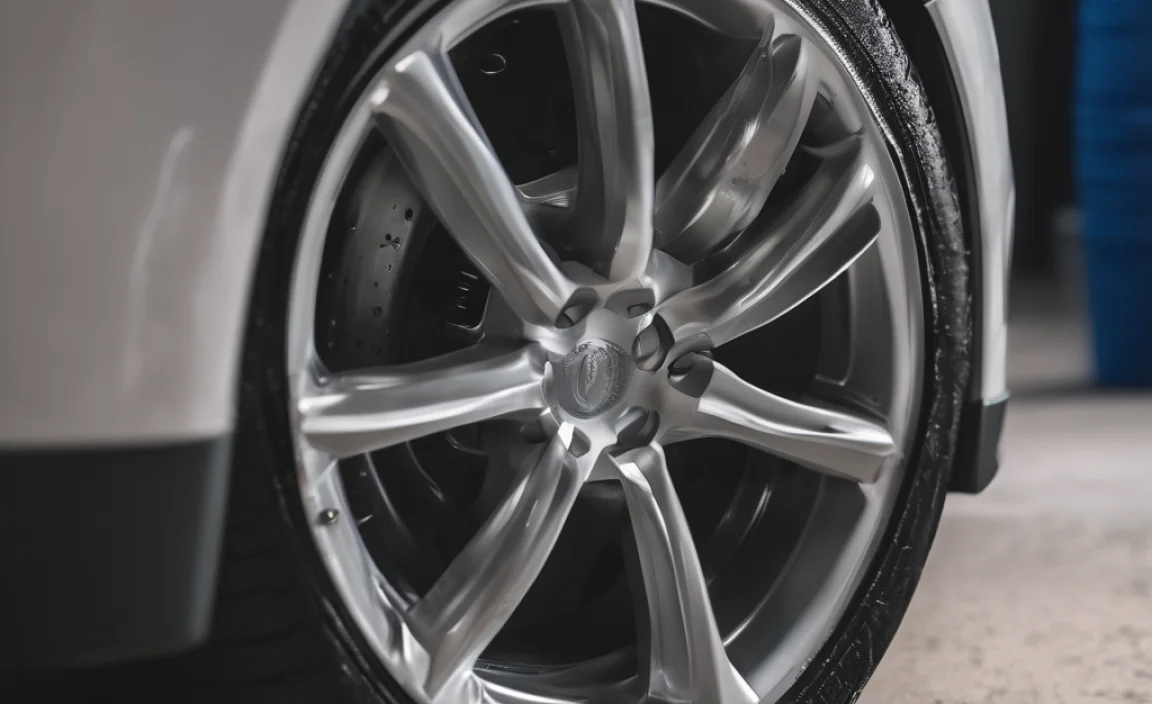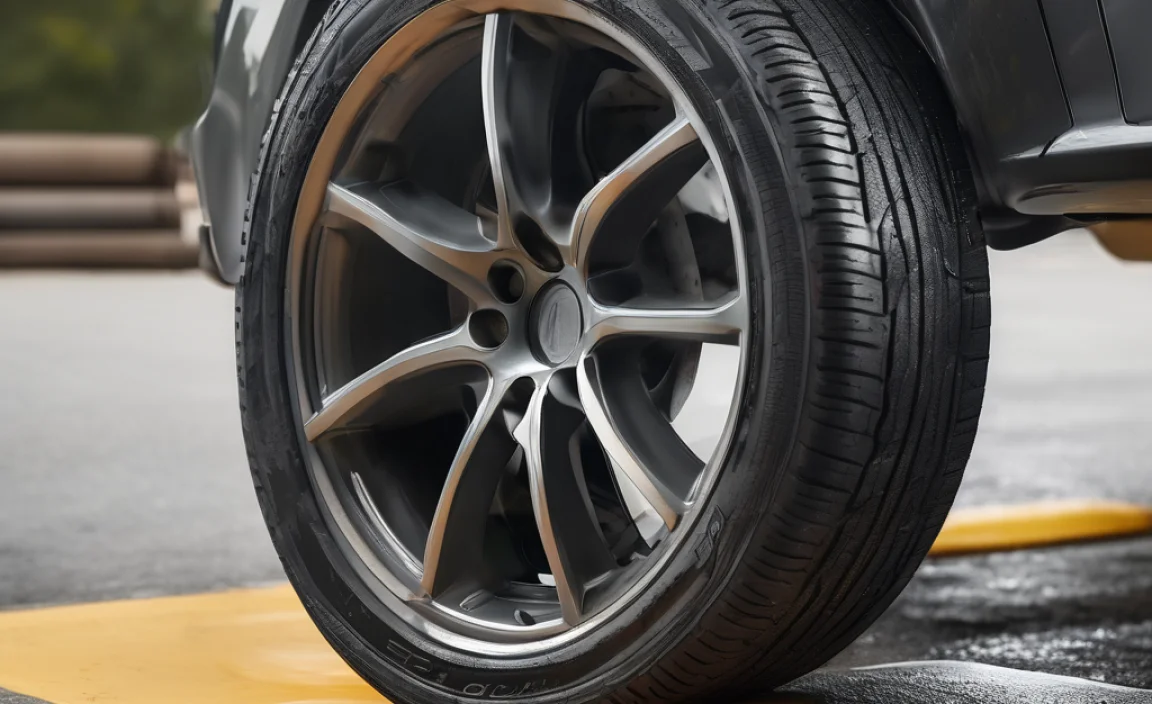Tire sealant can sometimes temporarily fix minor rim leaks by sealing small gaps between the tire and rim. However, it’s not a permanent solution and may not work for larger leaks or damaged rims. Always inspect the rim for damage and consider professional repair or tire replacement for safety.
Dealing with a tire that keeps losing air is super annoying, right? You pump it up, and then a few days later, it’s flat again. Sometimes, the problem isn’t a puncture in the tire itself, but a leak around the rim. This can happen for several reasons, like a slightly corroded or damaged rim edge. It’s a common headache for car owners, but don’t worry, there are solutions you can try!
One quick fix that often comes to mind is tire sealant. But does it actually work for rim leaks? In this guide, we’ll walk you through everything you need to know about using tire sealant for rim leaks. We’ll cover when it can help, when it won’t, and how to use it properly. Ready to get started and keep your tires properly inflated?
Understanding Rim Leaks

Before we dive into tire sealants, let’s quickly cover what rim leaks are and what causes them. Knowing this will help you understand if sealant is the right solution for your situation.
What is a Rim Leak?
A rim leak happens when air escapes between the tire and the rim of your wheel. This isn’t the same as a puncture in the tire’s tread. Instead, the air is seeping out from where the tire bead (the edge of the tire) sits against the metal rim.
Common Causes of Rim Leaks
- Corrosion: Over time, rust can form on the rim, creating a rough surface that doesn’t seal well with the tire.
- Damage: Dents or bends in the rim from hitting potholes or curbs can break the seal.
- Dirty Surfaces: Dirt, debris, or old tire sealant can interfere with the tire bead seating properly.
- Improper Mounting: If the tire wasn’t correctly installed, the bead might not be seated evenly.
- Valve Stem Issues: While not strictly a “rim leak,” a faulty valve stem can also cause air loss around the rim area.
Can Tire Sealant Fix Rim Leaks?

Now, let’s get to the big question: Can tire sealant actually fix a rim leak? The answer is, it depends.
When Tire Sealant Might Work
Tire sealant can be effective in certain situations, especially for minor leaks. Here’s when it’s most likely to help:
- Small Corrosion Issues: Sealant can fill tiny gaps caused by minor surface rust.
- Temporary Fix: It can provide a short-term solution to get you to a repair shop.
- Preventative Measure: Some people use it to help prevent leaks on older rims that might be prone to corrosion.
When Tire Sealant Won’t Work
However, tire sealant isn’t a miracle cure. Here’s when it’s unlikely to solve your rim leak problem:
- Significant Damage: If your rim is bent, cracked, or has large areas of corrosion, sealant won’t hold.
- Large Gaps: Sealant can’t bridge big gaps between the tire and rim.
- Valve Stem Leaks: Sealant inside the tire won’t fix a faulty valve stem.
- Run-Flat Tires: Using sealant in run-flat tires can damage their sidewalls and compromise their safety features.
Types of Tire Sealants

If you’re thinking about using tire sealant, it’s good to know that there are different types available. Each has its pros and cons.
- Latex-Based Sealants: These are common and work well for small punctures and leaks. They’re easy to clean up but may dry out over time.
- Glycol-Based Sealants: These offer better freeze protection and can last longer than latex-based sealants.
- Aerosol Sealants: These come in a can with an applicator and often include an inflator. They’re convenient for roadside emergencies but may not be as effective for rim leaks.
Step-by-Step Guide: Using Tire Sealant for Rim Leaks

If you’ve decided to try tire sealant, here’s a step-by-step guide to help you do it safely and effectively. Remember, this is usually a temporary fix, so plan to get your tire and rim professionally inspected as soon as possible.
Step 1: Gather Your Supplies
Before you start, make sure you have everything you need:
- Tire sealant (choose the right type for your needs)
- Jack and lug wrench
- Gloves
- Eye protection
- Air compressor or tire inflator
- Wheel chocks
- Rag or paper towels
Step 2: Safety First
Park your car on a level surface, engage the parking brake, and use wheel chocks behind the wheels that you are *not* removing. This prevents the car from rolling.
Step 3: Locate the Leak
If you’re not sure where the leak is coming from, you can use a spray bottle with soapy water. Spray the soapy water around the rim where the tire meets the wheel. If you see bubbles forming, that’s where the air is escaping.
Step 4: Prepare the Tire
- Deflate the Tire: Use a valve core removal tool (if available) to fully deflate the tire. This helps the sealant distribute evenly.
- Break the Bead (Optional): If possible, break the tire bead from the rim. This isn’t always necessary, but it can help the sealant get closer to the leak. You can use a bead breaker tool or carefully drive over the tire sidewall with another car (being very cautious not to damage the rim or tire).
Step 5: Apply the Tire Sealant
- Read the Instructions: Follow the specific instructions on your tire sealant product.
- Attach the Applicator: Connect the sealant tube to the tire valve stem.
- Inject the Sealant: Squeeze the sealant into the tire. Use the recommended amount based on your tire size.
Step 6: Reinflate the Tire
- Remove the Applicator: Disconnect the sealant tube from the valve stem.
- Inflate the Tire: Use an air compressor or tire inflator to reinflate the tire to the recommended pressure (check the sticker on your driver’s side doorjamb or your owner’s manual).
Step 7: Distribute the Sealant
Drive the car for a short distance (a few miles) at a moderate speed. This helps the sealant spread around the inside of the tire and seal the leak.
Step 8: Recheck for Leaks
After driving, recheck the rim area with soapy water to see if the leak is sealed. If you still see bubbles, the sealant may not have worked, and you’ll need to consider other solutions.
Pros and Cons of Using Tire Sealant

Like any DIY fix, using tire sealant has its advantages and disadvantages. Here’s a quick overview:
| Pros | Cons |
|---|---|
| Quick and easy to apply | Not a permanent fix |
| Can temporarily seal small leaks | May not work for larger leaks or rim damage |
| Relatively inexpensive | Can make tire repair more difficult later |
| Can be applied on the roadside | May damage tire pressure monitoring systems (TPMS) |
Alternative Solutions for Rim Leaks
If tire sealant doesn’t do the trick, or if you’d prefer a more permanent solution, here are some alternatives to consider:
- Professional Tire Repair: A tire shop can dismount the tire, clean the rim, and reseat the tire properly. They can also inspect for damage.
- Rim Refurbishing: If corrosion is the issue, a shop can sandblast and refinish the rim to create a better seal.
- Tire Replacement: If the tire bead is damaged, or the rim is beyond repair, replacing the tire or the wheel might be necessary.
- Bead Sealer: This is a liquid rubber product that’s applied directly to the tire bead during mounting to create a better seal. A tire professional will need to apply it.
Maintaining Your Rims to Prevent Leaks
Prevention is always better than cure. Here are some tips for maintaining your rims and preventing leaks:
- Regular Cleaning: Wash your wheels regularly to remove dirt, salt, and brake dust.
- Inspect Regularly: Check your rims for signs of corrosion or damage.
- Proper Tire Inflation: Keeping your tires properly inflated helps maintain a good seal.
- Avoid Potholes: Drive carefully to avoid hitting potholes or curbs that can damage your rims.
- Professional Mounting: Have your tires professionally mounted and balanced to ensure a proper seal.
Safety Considerations
Working with tires and wheels can be dangerous if you’re not careful. Here are some important safety precautions to keep in mind:
- Always use jack stands: Never work under a car supported only by a jack.
- Wear safety glasses: Protect your eyes from debris.
- Wear gloves: Protect your hands from chemicals and sharp edges.
- Follow product instructions: Read and follow the instructions on all tire sealant and repair products.
- If in doubt, consult a professional: If you’re not comfortable performing any of these steps, take your car to a qualified mechanic.
Cost Analysis
Let’s break down the costs associated with different solutions for rim leaks:
| Solution | Estimated Cost | Notes |
|---|---|---|
| Tire Sealant | $10 – $30 | DIY solution, temporary fix |
| Professional Tire Repair | $20 – $50 | Includes dismounting, cleaning, and reseating |
| Rim Refurbishing | $80 – $200 per rim | For corrosion or minor damage |
| Tire Replacement | $80 – $300 per tire | If the tire bead is damaged |
| Wheel Replacement | $100 – $500 per wheel | If the rim is beyond repair |
When to Call a Professional
While DIY solutions can be tempting, there are times when it’s best to call a professional. Consider seeking professional help if:
- You’re not comfortable working on your car.
- The leak is large or persistent.
- The rim is visibly damaged.
- You’re not sure how to properly inflate a tire.
- Your car has a tire pressure monitoring system (TPMS) that might be affected by sealant.
Conclusion
So, does tire sealant work on rim leaks? It can, but it’s not a guaranteed or permanent fix. It’s best for minor leaks and as a temporary solution to get you to a repair shop. Always prioritize safety, and if you’re not comfortable with DIY repairs, don’t hesitate to seek professional help. Keeping your tires properly maintained is crucial for safe driving, so address those rim leaks promptly and enjoy the ride!
FAQ About Tire Sealant and Rim Leaks
Here are some frequently asked questions about using tire sealant for rim leaks:
Q: Will tire sealant damage my tires or rims?
A: Generally, no, but it’s essential to use a quality sealant and follow the instructions. Some sealants can potentially interfere with tire pressure monitoring systems (TPMS), so check the product label.
Q: How long does tire sealant last?
A: Tire sealant is typically a temporary fix, lasting from a few days to a few weeks. It’s not a substitute for a proper repair.
Q: Can I use tire sealant on run-flat tires?
A: No, it’s generally not recommended to use tire sealant on run-flat tires as it can damage the tire’s sidewall and compromise its run-flat capabilities.
Q: Is it safe to drive with a tire that has a rim leak?
A: Driving with a tire that has a rim leak can be dangerous, as the tire can lose pressure rapidly, leading to a blowout. It’s best to address the leak as soon as possible.
Q: How do I clean up tire sealant if it doesn’t work?
A: Most tire sealants can be cleaned up with water and a rag. However, some sealants may require a solvent. Check the product instructions for specific cleaning recommendations.
Q: Can tire sealant affect tire balance?
A: Yes, tire sealant can sometimes cause tire imbalance, especially if too much is used. If you notice vibrations after applying sealant, have your tires rebalanced.
Q: Will a tire shop repair a tire that has sealant in it?
A: Yes, but be sure to let them know you have sealant in the tire. It may make the repair process a little messier, and they might charge a small fee for the extra cleanup.


